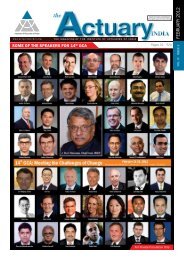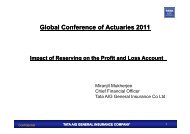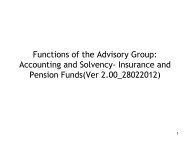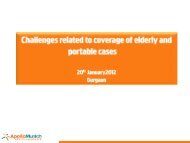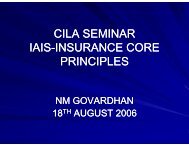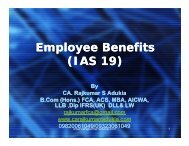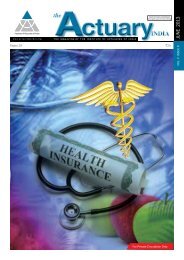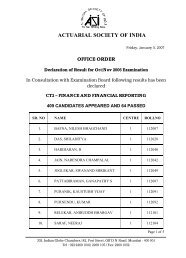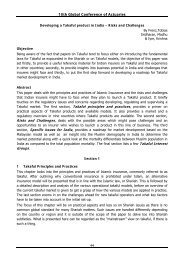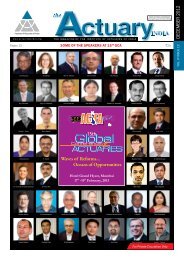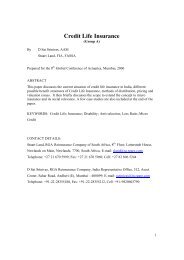January - Actuarial Society of India
January - Actuarial Society of India
January - Actuarial Society of India
You also want an ePaper? Increase the reach of your titles
YUMPU automatically turns print PDFs into web optimized ePapers that Google loves.
THE ES OF<br />
FROM THE DESK OF CHAIRPERSON -<br />
AVIJIT CHATTERJEE<br />
LIFE INSURANCE ADVISORY GROUP (LIAG)<br />
FRO<br />
S<br />
ince I last shared the view from my<br />
desk, much has changed or is in the<br />
process <strong>of</strong> changing. In particular, we<br />
are all coming to understand the effects<br />
<strong>of</strong> the regulatory changes implemented<br />
in September 2010 on policyholders<br />
and on our businesses.<br />
The most important effect appears to<br />
me to have been in the treatment <strong>of</strong><br />
expense and persistency risks in unit<br />
linked business. Firstly, the extent <strong>of</strong><br />
expense risk was increased as charges<br />
came to be limited, and secondly,<br />
persistency risk was largely allocated to<br />
companies rather than to policyholders.<br />
We are now in a position where the risks<br />
arising from expenses and persistency<br />
are largely allocated to policyholders in<br />
conventional savings business, and to<br />
the company in unit linked business.<br />
In both cases, it is imperative that the<br />
underlying issue <strong>of</strong> poor persistency be<br />
addressed if the industry is to prosper.<br />
Expenses and persistency are <strong>of</strong><br />
course, to a great extent, two sides <strong>of</strong><br />
the same coin: a level <strong>of</strong> expense that<br />
can comfortably be borne in a 10-year<br />
policy can appear egregious if applied<br />
to a 5-year policy. So the solution must<br />
avijit.chatterjeeiciciprulife.com<br />
be tw<strong>of</strong>old: rstly to become more<br />
efcient, in particular in distribution,<br />
and secondly to improve policyholder<br />
persistency. The principal difculty in<br />
reaching such a solution is in improving<br />
the quality <strong>of</strong> sales, so as to generate<br />
higher policyholder persistency, while<br />
simultaneously reducing their cost.<br />
To help us see a solution through these<br />
difculties, at this year’s GCA, in the<br />
sessions devoted to life insurance, we<br />
have scheduled some time to focus<br />
on the problem <strong>of</strong> persistency. The<br />
session will be chaired By r Sudhin<br />
Roy Choudhury, ember (Life, IRA,<br />
and will comprise presentations from<br />
a range <strong>of</strong> domestic and international<br />
experts followed by a panel discussion.<br />
The session will be followed by detailed<br />
consideration <strong>of</strong> the <strong>India</strong>n life<br />
insurance market from an international<br />
perspective and with some prognosis <strong>of</strong><br />
its future. To help disperse any lingering<br />
cloud, we shall then turn to the potential<br />
growth area <strong>of</strong> disability insurance.<br />
Lastly, two eminent anaging irectors<br />
<strong>of</strong> <strong>India</strong>n life insurance companies will<br />
share their ideas on the future for their<br />
companies and for the industry.<br />
Turning from the GCA, the activities <strong>of</strong><br />
the LIAG have continued unabated over<br />
the course <strong>of</strong> the year, principally in<br />
three areas:<br />
1. We have recommended to Council<br />
<strong>of</strong> the Institute revisions to<br />
existing guidance notes or practice<br />
standards in respect <strong>of</strong> peer review<br />
and disclosures to be made in an<br />
IPO, as well as recommending two<br />
brand new guidance notes;<br />
2. We have provided feedback on<br />
proposed regulatory changes when<br />
the pr<strong>of</strong>ession has been consulted<br />
by the Regulator, in particular in<br />
matters <strong>of</strong> product design; and<br />
3. We staged a successful and<br />
stimulating seminar on Current<br />
Issues in Life Assurance (CILA in<br />
November. Wide-ranging discussions<br />
covered product and reinsurance<br />
regulation, risk-based capital, the<br />
role <strong>of</strong> the appointed actuary, etc.<br />
If you are interested in participating in<br />
LIAG’s activities, please get in touch, as<br />
there is more than enough work to go<br />
round.<br />
I look forward to hearing from you,<br />
mployee enets onsulting Pr<strong>of</strong>essional onduct Issues<br />
WHY ATTEND 15 Th GCA? ... TEASERS FROM SOME SPEAKERS...<br />
Concept, Connotations and Current framework<br />
arket Practices and Asymmetries<br />
Global Best Practices<br />
Blueprint for the Future<br />
C2: Concurrent Sessions on Pension, Employee Benets & Social Security<br />
K. Subrahmanyam and K. Sriram, <strong>India</strong><br />
General Insurance concurrent session<br />
In the wave <strong>of</strong> regulatory changes related to insurers’ solvency, insurers worldwide are considering the usage <strong>of</strong> Economic<br />
Capital (EC models to calculate the amount <strong>of</strong> capital they need to set aside for contingencies. EC models help companies<br />
to identify and measure the risks they are facing, as well as, promote a culture <strong>of</strong> risk management within the organization.<br />
While building a fully integrated EC model may require expensive modeling tools, General Insurance rms in <strong>India</strong> may think<br />
<strong>of</strong> low cost excel/R based risk aggregation techniques as a rst step towards building EC models.<br />
C4: Concurrent Sessions General Insurance Charles Cicci and Arijit Das, <strong>India</strong><br />
6 The Actuary <strong>India</strong>



